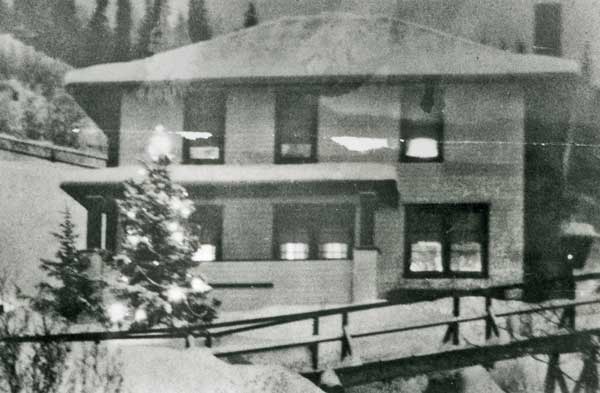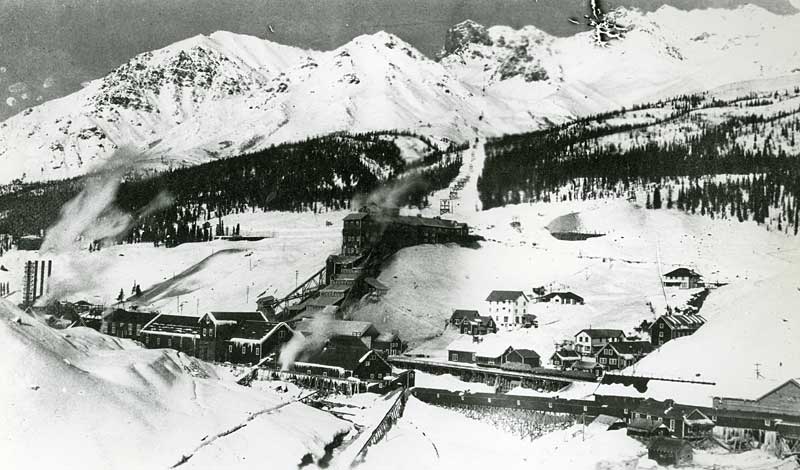Power was to originate from a dam about two miles down the creek at a narrow point in the canyon, but this plan was abandoned in favor of building a power house right in McCarthy where there was ready access to fuel brought in by the railroad. By 1916 this power plant and a thirteen-mile string of power lines was in operation all the way up the McCarthy Creek canyon to the base and upper camps. A narrow road was also extended from the town, crossing more than a dozen bridges, following the creek grade all the way to the lower camp. This would enable year-around transporting of ore from the mine to town, where it could be loaded at Shushanna Junction, which was the railroad yard near McCarthy. Ore had been hauled only in the winter, sledded down the creek in limited quantities. Although there was now a road and power, there still remained the need for a mill, as it was only economical to ship very high-grade ore over the Copper River and Northwestern Railway and then the Alaska Steamship Lines to the Tacoma smelter. By 1918, the mine was still only in limited production, as there had not been enough capital raised to build a mill or purchase special ore trucks to run the narrow road to McCarthy. Almost all of the development had been limited to the Marvelous vein, which lay in the rock face north of the upper camp in the upper elevations of the ridge which separates Mother Lode gulch from Marvelous gulch. Mother Lode was sitting on what appeared to be an ore vein of high potential, but the developers had so far failed to raise the necessary capital for the development required to exploit the situation. Additionally, the company had not been successful in gaining favorable haulage rates from the CRNW Railway, which was wholly-owned by Kennecott Copper, the competition. The Marvelous vein simply did not show enough potential to attract the needed investment capital. What the company failed to realize was that the true “Mother Lode” lay directly beneath the upper camp, not quite 400 feet straight down. Mother Lode Company ran several prospect tunnels searching for the elusive vein which would bring in the investment money before it was too late. A main tunnel, at what was to become the Bonanza 800 level, headed to the northwest for a distance of several hundred feet. They named it the Rhodes tunnel. Directly above it, near the lower limit of Marvelous vein, the Pittsburg tunnel was started. In an attempt to find additional ore, a two-compartment vertical shaft was driven from a point well inside the Rhodes tunnel. The Mother Lode vertical shaft, ultimately extended a vertical distance of 850 feet from the 600 level down to the 1450 level. But most of that work was done by Kennecott. The original tunnel was not successful in driving the tunnel far enough down. Ironically, had the ML extended it another hundred feet in 1918, the old company would have discovered the true Mother Lode and could have found financing independent of theKennecott Corporation. They were on the right track, but they ran out of time. Kennecott would benefit enormously from this failure. Then came the severe winter storms. There had been no storms like these since the railroad arrived. One winter snow storm after another dumped load after load of snow over the entire upper Chitina and Nizina valleys. The build-up was perilously high in late April when the melting actions of early spring finally set off those first avalanches. Every aerial tram on the ridge was damaged by those slides, which increased in frequency and intensity until the upper towers at the Jumbo, Bonanza and Mother Lode mines, along with the power transmission towers, were knocked out of position or completely destroyed. The two Kennecott upper camps were isolated for days, having no form of communication due to the lines being down and tram access gone as well. But it was much worse at Mother Lode. The upper camp was severely damaged and most of the tram towers were completely down. The power line which followed the creek floor was heavily damaged as well. The men who were at the upper camp had to stay in the tunnels while the avalanches were busy taking out everything in sight. Remarkably, the main part of the upper camp was repairable, as it was above the area where most of the snow slides occurred. But an already cash-strapped company now needed to make some sort of deal with Kennecott--something which had been avoided up until now. There was no other choice if there was any hope of holding onto the already considerable investment at Mother Lode. Although Kennecott had experienced considerable damage as well, the corporation had deep pockets and was prepared to handle emergencies of this kind. It also had the investment capital on hand for the right opportunity to buy into the Mother Lode operation across the ridge.
He paused long enough to look up toward the dark hulk on the hill. The Stephen Birch guest house was now barely visible through the darkness and blowing snow. Frank again stood up and pressed is face against the cold glass. It was really dark out there. The lights in the Douglass house had gone out. Only the dim porch lights of the three entryways on the upper level of the hospital could be seen. He sat back down and took a sip of the tea. Ellen had sweetened it slightly with sugar and lemon. It was a pleasantly hot treat. He could feel coolness coming through the glass and maybe even the walls. Frank pulled the heavy robe more tightly around himself and continued. The early owners of Kennecott--the Alaska Syndicate, which mainly consisted of the Guggenheim family, J.P.Morgan, and just a few others--had the opportunity early on to pick up the Mother Lode claims, but failed to do so. Ocha Potter, representing Mother Lode, had tried to interest them before any development work began there, but the syndicate’s consulting engineer failed to make a close inspection of the site. He was too old and did not want to make the long climb up the hill. He concluded that there would was no copper of any economic value in the ML properties. That was the end of that for a while. Mother Lode worked the Marvelous vein, which is the reason we are re-opening the camp over there. We have decided to complete the work the old company left behind at Mother Lode in order to determine the likelihood of any adjacent large copper ore bodies. But Marvelous, by itself, would not have been enough to interest Kennecott into picking up the entire site. However, by 1914, a new much younger consulting engineer took another look at the lay of the Bonanza vein and concluded that it probably extended well into the adjacent Mother Lode properties. He projected the main vein at about 400 feet below the main adit at Mother Lode. This information was kept confidential. But Kennecott was now ready to take advantage of any situation which would give it control over the adjacent properties. Then came the snow slides of 1918. In very short order, the deal was made, and an all-new Mother Lode Coaltions Company was formed. As an interesting side note to all of this, when Kennecott picked up ML, it also obtained the power plant at McCarthy. This continued to operate until power could be run over to the ML workings through the 800 crosscut. Then the plant at McCarthy was shut down. It was still sitting completely intact when the Kennecott power plant burned down two years ago. The availability of those generators allowed us to resume operation that year much earlier than would otherwise have been possible. I have written enough about ML. Thank you for tolerating my probably boring letter. But then, as a fellow engineer, you can understand that. I must admit that this time of year, with no family, it is good to have a few old friends with whom I can correspond. Thanksgiving day is just around the corner here. The company provides a special dinner to all of us on that day, but I’ll probably enjoy a dinner with the other engineers at the superintendent’s home. I have never lost my fondness for turkey with all the trimmings. If I recall we were taught as schoolchildren that the Indians saved the first of us white people by providing badly needed food. We have two Indians--they’re called ‘Natives’ up here--who are now working at Erie. I was able to convince the super to hire them for the first time back in 1924. I had met one of them the year before when I took the train in from Cordova in a very strange place called Chitina. This Native, who is about my age, works with a cousin who calls himself Cap.The two of them have worked here three times. They have added much to this camp. It has never been so interesting, even though the two of them think they are making themselves inconspicuous. The team works so well together and is so daring in what they do that they far outshine almost everyone else. They have proven to be about the finest workers I have ever encountered. I understand that they will be assigned to the Marvelous Project. With them there, I will probably never have a dull moment. I might add that those two are literate and surprisingly articulate. Never let it be said that the “lowly Indian” cannot take care of himself. These two are living examples of the best there is in Alaska. They take extreme pride in their work, they work very hard, they think the problem through, and they won’t let anyone tell them “it can’t be done.” That happens to be a description of the ideal engineer and miner at Kennecott. That is what Kennecott is all about. I certainly miss those old days on the ranch in Wyoming, but that’s becoming a distant memory now. Be sure to write back and let me know how things are progressing for you at Anaconda’s Butte Mine. With many regards, Your old friend in the north country, Frank Buckner 12 November, 1926 Kennecott, Territory of Alaska
|
Chapters from the historic novel "Legacy of the Chief," by Ronald Simpson, and other items mostly related to the historic background of the Ahtnas in the context of Kennecott Copper & its Copper River & Northwestern Railway.
10 February 2011
Ch 46, Pt 2: "Frank's Thanksgiving Letter"
Subscribe to:
Post Comments (Atom)



No comments:
Post a Comment